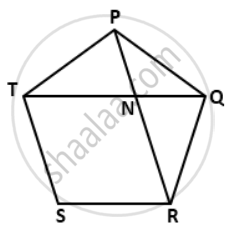Advertisements
Advertisements
प्रश्न
In a regular pentagon PQRST, PR = QT intersect at N. Find the angle RQT and QNP.
उत्तर

Each interior angle of a regular pentagon
= `((5 - 2) xx 180°)/(5)`
= 3 x 36°
= 108°
Now, In ΔPQT,
⇒ PT = PQ ....(sides of a regular pentagon)
∠PQT = ∠PTQ = x(say)
Now, ∠QT + ∠{TQ +∠QPT = 180°
⇒ x + x + 108° = 180°
⇒ 2x = 72°
⇒ x = 36°
⇒ ∠PQT = ∠PTQ = 36°
Similarly, we can prove that in ΔPQR,
∠QPR = ∠QRP = 36°
Now, ∠RQT
= ∠RQP -∠PQT
= 108° - 36°
= 72°
In ΔQNP,
∠PQN +∠QPN + ∠QNP = 180°
⇒ 36° + 36° + ∠QNP = 180°
⇒ ∠QNP = 180° - 72°
⇒ ∠ QNP = 108°.
APPEARS IN
संबंधित प्रश्न
The difference between an exterior angle of (n - 1) sided regular polygon and an exterior angle of (n + 2) sided regular polygon is 6° find the value of n.
In a polygon, there are 5 right angles and the remaining angles are equal to 195o each. Find the number of sides in the polygon.
In a parallelogram ABCD, AB = 20 cm and AD = 12 cm. The bisector of angle A meets DC at E and BC produced at F.
Find the length of CF.
Is it possible to have a polygon whose sum of interior angles is 780°?
If the difference between an exterior angle of a regular polygon of 'n' sides and an exterior angle of another regular polygon of '(n + 1)' sides is equal to 4°; find the value of 'n'.
KL, LM and MN are three consecutive sides of a regular polygon. If ∠LKM = 20°, find the interior angle of the polygon and the number of sides of the polygon.
The ratio between the number of sides of two regular polygon is 3 : 4 and the ratio between their interior angles is 2 : 3. Find the number of sides of each polygon.
Find the value of each angle of an octagon if four of its angles are equal and the other four are each greater than these by 20°.
The sum of the interior angles of a polygon is 6.5 times the sum of its exterior angles. Find the number of sides of the polygon.
In a hexagon JKLMNO, side JK || ON and ∠K : ∠L : ∠M : ∠N = 6 : 5 : 4 : 3. Find the angle ∠K and ∠M.
